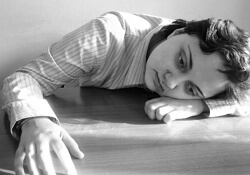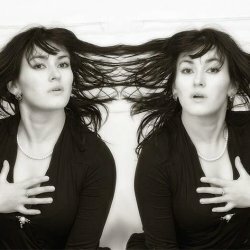Asthenia
 Asthenia is a psychopathological disorder that gradually progresses. Symptoms of asthenia are high fatigue, also characterized by exhaustion of attention, while there is a lability of emotions with instability and significant mood jumps. At asthenicized patients, self-control is weakened, they are impatient and often irritated.
Asthenia is a psychopathological disorder that gradually progresses. Symptoms of asthenia are high fatigue, also characterized by exhaustion of attention, while there is a lability of emotions with instability and significant mood jumps. At asthenicized patients, self-control is weakened, they are impatient and often irritated.
Asthenia significantly reduces the ability to work, there is an intolerance of various stimuli: sound, visual, as well as sharp odors. The course of mental, neurological, somatic diseases is complicated by asthenia. This disorder does not have a specific age category or gender.
Asthenia - what is it?
Asthenia is a psychopathological condition characterized by weakness, pronounced tiredness, incontinence of emotions with instability of mood, irritability, hyperesthesia, sleep deprivation.
Asthma is a condition of the pathology of the psyche, which unites several syndromes. The main ones are neurotic, and also cerebrosthenic. This type of asthenia often indicates a vascular pathology, mainly affected by the vascular plexus of the brain. Old age asthenia occurs in people of advanced age, namely after 65 years. Cerebral asthenia, which manifests itself in the beginning of the disease, eventually leads to vascular dementia, or dementia.
Asthenic syndrome occurs in the practice of every doctor. Symptoms of asthenia, nonspecific and very often it is the initial stage of mental disorders. The reason is often a violation of the neurotic structure, which in the future attracts more complex, up to irreversible diseases.
Asthenic disorders due to their nonspecificity are quite common. Most people have experienced the symptoms of this disease. Studies indicate an increase in asthenia in the population, this can be explained by the fact that modern people are constantly exposed to high levels of stress, especially dangerous stress.
Separately isolated neurasthenia, its main manifestation is irritable weakness. This term was first used in the XIX century, but it is still relevant. This disease was first described by G. Byrd. Even in the main classification of diagnoses ICD-10 neurasthenia remained as an independent nosological unit, this confirms the real presence of such a state and the importance of an individual therapeutic approach.
Neurocirculatory asthenia is a complex of disorders, of which the key are vegetative disorders. Stability of our body is provided by many systems, among them an important role is played by vegetative. Changes or disturbances in her work lead to a change in the whole organism. Neurocirculatory asthenia is a diagnosis-exception, which can be set with a complete examination of the body and the absence of any structural pathology. There are several types of neurocirculatory asthenia: cardiac, hypertonic, hypotonic, vagotonic and mixed. The most common is the first type.
Functional asthenia is not associated with organic pathology. Its main difference from neurocirculatory asthenia in the absence of pronounced autonomic dysfunction. It often occurs in healthy people who have undergone a variety of stress factors. Functional asthenia is detected in half the cases and when properly diagnosed completely passes. Gastral asthenia is a subspecies functional, the main symptom is the disruption of the digestive system. And although no organic pathology is detected, this form can bring considerable discomfort and greatly lowers the quality of life.
Causes of asthenia
Given the many species and the impressive prevalence of asthenia, there are several groups of causes of asthenia.
The first is the causes that form organic asthenia. These are somatic diseases, structural organ damage, trauma and surgical interventions. The following are the main organic causes.
• Diseases of the cardiovascular system: all kinds of arrhythmias, arterial hypertension and all kinds of secondary hypertension, ischemic disease, especially myocardial infarction, carditis.
• Lesions of the gastrointestinal system: pancreatoduenitis, gastroenterocolitis, peptic ulcer, dyspeptic disorders.
• Pathology of the genitourinary system - cystitis, chronic kidney disease, pyelonephritis, glomerulonephritis.
• Endocrine pathology: diabetes mellitus, hypo- and hyperthyroidism, adrenal pathology.
• Hematological diseases: leukemia, anemia, thrombocytopenia and thrombocytopathy.
• All systemic diseases, allergies and oncopathology, as well as neurological diseases, strokes. Congenital pathology of the kidneys, lungs, heart defects.
• Infectious diseases: meningitis and encephalitis, tuberculosis, hepatitis A, B, C, D, E, influenza, as well as other types of SARS, HIV and AIDS, as its final stage.
• Organic asthenia is also included in the structure of degenerative brain diseases: Alzheimer's disease, Pick's disease, various types of dementia.
Common characteristic causes of asthenia: nerve strain;Malnutrition, lack of important trace elements;Pathology of metabolism. These prerequisites can transform into asthenia with additional factors.
Functional asthenia can occur acutely with sudden stress or overload at work or is of a sluggish chronic nature: in women after childbirth, with the syndrome some drugs such as antidepressants, neuroleptics or drugs( alcohol, nicotine, etc.) are canceled,.
As mental illness accompanies anxiety, insomnia and fear, all mentally ill people quickly astheniziruyutsya.
Neurocirculatory asthenia occurs when the autonomic nervous system is disrupted. Also negatively affect stress, negative iatrogenic influence of physicians. Hypodynamia, chronic fatigue, elevated levels of radiation, malnutrition also leads to the development of neurocirculatory asthenia. It can lead to chronic diseases of the respiratory system, tonsillitis, hyperinsolations, chronic intoxications of the body.
There are also factors, the presence of which increases the risk of this disease: hormonal fluctuations, for example, when taking hormones, pregnancy or abortion;Hereditary mental preconditions, inferiority of neurohormonal systems;Low level of social conditions.
Asthenia occurs more often in elderly, single women with a low level of intelligence who live in remote villages and can not provide themselves with a high level of living conditions. The main reason - irreversible changes in the brain due to the gradual degeneration of neurons. The cause of degeneration is the age-related changes and pathologies of the vessels, for example, their atherosclerotic lesion.
Symptoms and signs of asthenia
All symptoms of asthenia have three groups.
♦ The first group is actually the manifestation of asthenia as a psychopathological syndrome. Listed below are the main symptoms related to this group.
Fatigue is the first thing that worries patients, and they talk about it with their family doctor. It is very important not to overlook this complaint and to question the patient in detail when it appeared and how it manifests itself. We all experience fatigue, but this is not asthenia. It is important that with fatigue, fatigue remains after rest and significantly complicates life. Such people are scattered, anxious, lack of initiative, and eventually lose their capacity for work.
Vegetative symptoms. Changes in blood vessels and heart: acceleration of the heartbeat, pulse interruptions, pressure jumps. Dermograph reactions are easy to develop. There may be fever or chills, increased local or general sweating. Often there are discomfort in the stomach, dyspeptic disorders and spastic constipation. There is also a headache, different for character and localization.
Change of sleep. Dream is shallow with a lot of unpleasant dreams, people often wake up and can not fall asleep. After sleep, there does not come a sensation of full rest, and drowsiness remains in the daytime.
People with asthenia feel relatively well in the morning, and by the evening their condition worsens.
♦ The second group is the symptoms of the underlying disease that occur with asthenia. Depending on the disease, which plagues the patient, complaints can be radically different. They are diagnosed by doctors of different profiles.
The course of asthenia is different for different diseases. With neurosis, muscle tone is increased, especially striated muscles are involved. Muscle tone is reduced, if there is chronic circulatory failure, a person becomes sluggish. There is an incontinence of emotions, uncaused crying. Thinking is difficult and slow. With neoplasias that affect the brain, weakness and apathy are expressed. Symptoms resemble myasthenia gravis: irritability, hypochondria, anxiety, as well as the pathology of sleep.
Traumatic asthenia, depending on the degree of injury, can be functional - chopping, and organic - encephalopathy. With encephalopathy, the patient weakens. Memory worsens, emotions are unstable. These people are irritable, but the condition can dramatically change to lethargy and indifference to the environment.
New knowledge is poorly assimilated. The cerebral manifestation is less pronounced, but its course is continuous. With proper care, its symptoms practically disappear, but with minimal overloads become aggravated. After acute respiratory infections, asthenia is initially hypersthenic. Nervousness, a sense of inner discomfort and irritability do not leave the patients. With complicated infections, a more severe hyposthenic asthenia develops. The patient is inactive, weak and drowsy, and any rustles irritate him. Over time, there is a decrease in working capacity, an unwillingness to work. With prolonged flow there are vestibular disorders, memory impairment, absent-mindedness.
♦ The third group of symptoms occurs as a patient's reaction to his asthenic state. A person does not understand his state and experiences, therefore the character changes. Patients become rude, aggressive, often lose composure. If asthenia is not treated, then depression and neurasthenia can develop.
Treatment of asthenia
In order to cure asthenia, it is necessary to properly treat the disease, against which it originated. To do this, it is necessary to diagnose it in time and prescribe the appropriate treatment. If therapy of the underlying disease is prescribed, you can go on to treat asthenia proper. For this it is worthwhile to take advantage of the developed stage scheme, which is common in the practice of doctors.
Day regimen. It is very important to plan your day schedule so that you can have a rest, daily walks on the street, especially useful before bedtime. Useful moderate exercise, they help keep the body in good shape. When asthenia is favorably influenced by water exercises, swimming, contrast shower. It is desirable to abandon the addictions and various excesses. Some patients should even choose another type of activity.
You need a healthy and balanced diet. A nutritious breakfast that will provide a quarter of the daily calorie level. It should include complex carbohydrates: cereals, cereals, and the like. Useful products, which contain an indispensable amino acid tryptophan - dairy products, eggs, bananas, turkey meat, whole grain bread. It is important to eat meat, fish, nuts, vegetables. It is harmful to overwork, you need to rest on time. Favorably affects the use of seasonal vegetables, fruits, berries.
Traditional treatment begins with the reception of adaptogens - tincture of the root of ginseng, leaves of magnolia vine, eleutherococcus grass. Vitamins in combination with microelements - Zn, Mg, K, Ca, help well. Vitamin B1 -2.5% - 2ml intramuscularly, Ascorbic acid 5% - 2ml intramuscularly 1p / day, duration is one month.
Nootropics are used when the brain activity worsens, which is confirmed by psychological tests or objective data. Aminalon - gamma-aminobutyric acid 300-1000 mg / day. Acetan has a mild stimulating effect, a dose of 300-1000 mg / day. Piriditol improves the energy metabolism of glucose in the brain, a dose of 0.3-0.4 g a course of 1-3 months. Piracetam - stabilizes the cerebral function, the dose: 20-30g / day.
It is better to assign an antidepressant to a psychiatrist according to strict indications. Antidepressants with a stimulating effect are better suited. Pyrazidol 150-200 mg / day, Azafen 150-200 mg / day, Melipramine 200-250 mg / day, and monoamine oxidase inhibitors.
Such patients are also helped by some methods of psychotherapy: suggestive therapy, autogenous relaxation, occupational therapy, sociotherapy and art therapy, aromatherapy and music therapy.
Alternative medicine: use of herbs with a soothing effect: mint, chamomile, lemon balm. You can take instead of tea, which has a mild soothing effect.
Some patients are shown sanatorium and spa treatment, but for the sake of a natural nature rest and relaxing massage with elements of stimulation.
Human health is normalized when a full course of treatment is completed. In the genome of individual individuals, there is a propensity for asthenia, which can lead to chronicization of this pathological condition. Preventive treatment, lack of stress and proper daily regimen greatly reduce the risk of recurrence.



